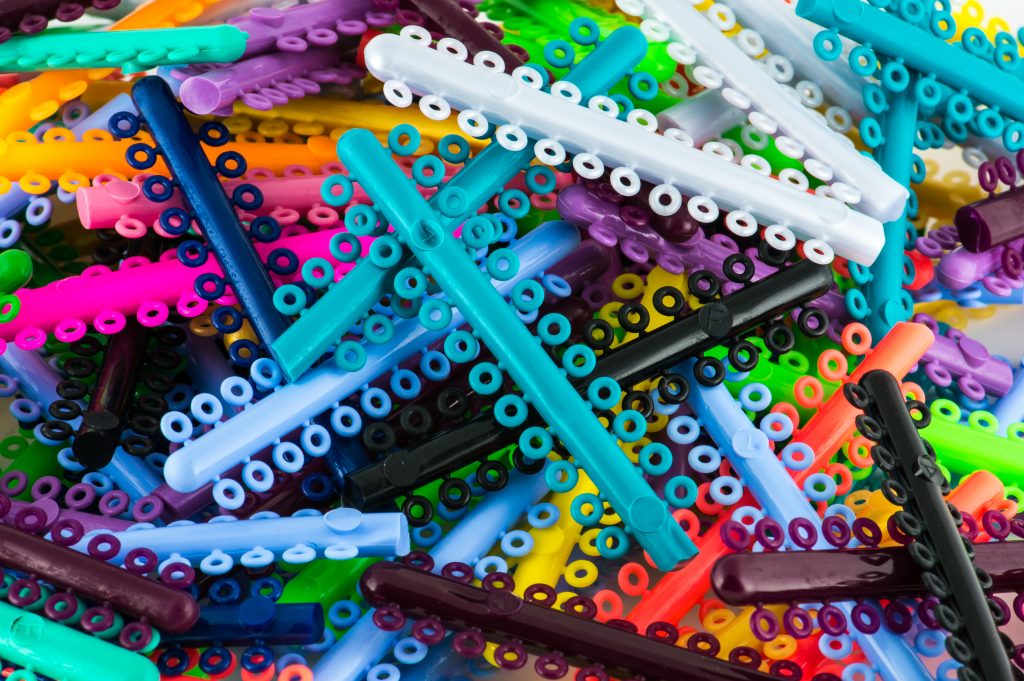Why Do I Need Rubber Bands With Braces?
- July 31, 2018

Orthodontic treatment can come with its fair share of challenges, from food restrictions to a more complicated oral hygiene routine, those appliances like brackets or aligner attachments taking some getting used to. If you are a current patient with Lincoln Orthodontics, you likely understand the role that the braces and aligners play in your overall treatment plan, but have you considered the purpose of the rubber bands or “elastics”? Most orthodontic patients will need to wear them at some point in their treatment process and just like everything else associated with orthodontic treatment with braces or aligners, they are an important part of the journey towards a beautifully straightened smile!
Rubber bands are often recommended in order to correct bite alignment, reduce an overbite or underbite, and in some cases, open or close spaces. This will help move your teeth into new and improved positions, giving you a more functional and attractive smile, as well as improving your overall oral health. Although any frustrating aspect of braces treatment is absolutely worth the end result, we want all of our patients to feel informed about and empowered by their orthodontic journey. We know that can be hard, especially if you don’t understand why you’re being asked to do something like wear rubber bands with your treatment. To learn more about why we use rubber bands in orthodontics with braces and how they work to benefit your smile, keep reading below.
The role of rubber bands in orthodontic treatment
Traditional braces are one of the most effective ways we have of aligning teeth and creating straighter smiles, but the same principles apply to clear aligner treatments. After brackets have been glued to the surface of the teeth or aligners are being worn, they begin to move the teeth using force that is produced by the set of wires or the aligner plastic that spans from tooth to tooth. Although this can successfully align the upper and lower sets of teeth separately, something must be connected between the upper and lower teeth to actually correct the bite. There are several options available for accomplishing this, such as headgear, springs, and other orthodontic appliances, but the most common method tends to be rubber bands, also known as elastics.
Rubber bands are a preferred method for a number of reasons. Less noticeable than other options like headgear, the tooth-colored elastics in particular blend in easily with your natural smile. For patients who prefer showing off more of their personality, we also offer elastics in a range of bright colors to choose from. Elastics are easy to remove and replace, which is important since this needs to be done by the patient frequently – usually every 2-3 hours if elastics have been prescribed full time. Because rubber bands are stretchy and flexible, they allow you to maintain a full range of motion when engaging in everyday activities like talking, yawning, eating, and brushing your teeth. Rubber bands are also cost-effective and extremely versatile. They can be used to correct most types of bite problems, including overbites, underbites, open bites, and crossbites.
The different types of orthodontic elastics
There are two types of orthodontic elastics, ligatures and rubber bands. Ligatures are the smaller elastics that fit around your brackets in order to help the archwire retain its position there. Ligatures are part of the process by holding the wire into the bracket that pulls or pushes your teeth in the direction required by the customized treatment plan Dr. Willett or Dr. Harre create for you.
Rubber bands are larger versions of elastics that can be placed in several different configurations to match the tensile force requirements and the vectors of bite correction needed for your mouth. They apply pressure on the jaw, assisting it in achieving the proper alignment for your bite. The most common configurations are the top-to-bottom and inter-arch configurations. Both ligatures and rubber bands are available in a wide variety of colors.

How orthodontic rubber bands work to straighten teeth
As ligatures, archwires, brackets, and aligners move the teeth along the gumline, rubber bands help to pull the jaw backward or forwards so that your bottom and top rows of teeth line up correctly. To begin this process, a bracket with a hook is placed along the left and right sides of your bottom and top teeth or a cutout hook is placed in the aligner. Rubber bands are then attached to these hooks on each side of the mouth. The amount of tensile force required to correct your orthodontic issues will determine the angle at which these bands are placed. Over time, this will improve your smile by fitting your teeth together more comfortably. Rubber bands also play an essential role in speeding up the overall orthodontic process, but this will rely entirely on you wearing your rubber bands exactly the way Dr. Willett and Dr. Harre direct you to. Their instructions for elastics are the prescription or the medicine they have directed for your individual needs. Patient compliance is incredibly important when rubber bands are being used in your treatment.
How to use your rubber bands correctly
In order to ensure your orthodontic treatment proceeds on schedule, it is crucial that you follow instructions carefully when wearing rubber bands. Not only will this provide you with optimal results, it will also help you avoid prolonging the treatment process.
To get the most out of your rubber bands, you’ll likely be advised to wear them 24 hours a day. This includes while you are sleeping. You will generally take them out only to brush, floss, put new bands in, and sometimes to eat, although this will depend on each individual case. Even if you think doubling up on bands will speed your treatment up, it is a bad idea and one we warn against. It can actually slow things down and potentially damage your roots.
It’s normal to experience some soreness in your mouth, teeth, and jaws the first few days you’re wearing rubber bands, but this should only be temporary if you are wearing the elastics as directed. Be sure to stay the course and keep them in as prescribed, as wearing your elastics incorrectly will make your teeth more resistant to moving successfully and slow down your progress. It can also keep your teeth constantly sore since they never have the chance to get used to the rubber bands.
Every time you take a band out, discard it for a new one. Depending on your specific case, your daily activities, and the strength of the elastic, you may find yourself replacing bands multiple times each day. To keep treatment on track, have a pack of bands with you at all times.

Keep your treatment on track with Lincoln Orthodontics
Rubber bands play an essential role in moving your jaw and teeth into the correct alignment necessary to achieve a healthy, aligned smile. Our team is here to help you throughout your orthodontic journey, from your initial consultation to the day your braces come off, and beyond! If the time has come for you to wear rubber bands with your braces, Dr. Willett, Dr. Harre, and the rest of our skilled staff are available to answer any questions you may have, address any concerns, or to simply offer extra encouragement when you need it. This part of your orthodontic journey is only temporary, and before you know it, you’ll have a beautiful smile that will last a lifetime.


